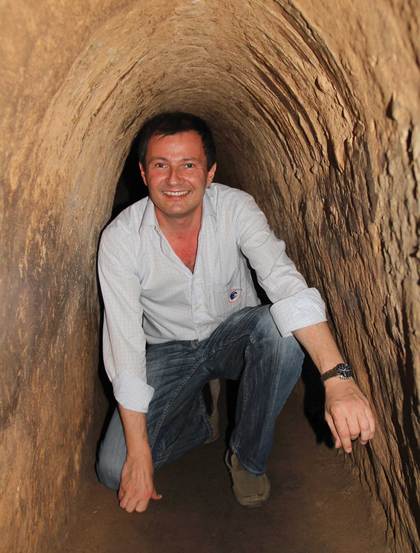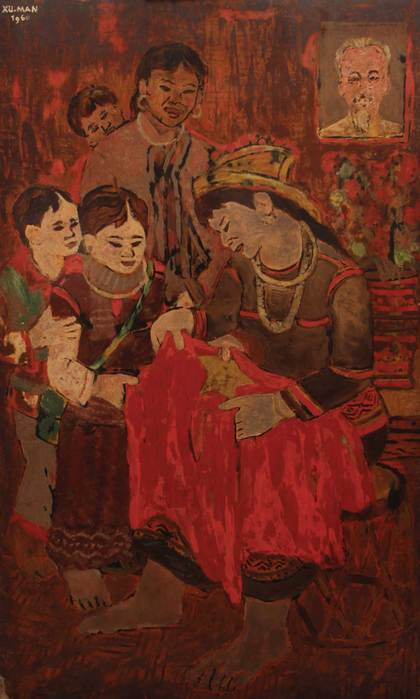Adrian Jones is not a familiar name in the who’s who of international art collectors. This 48-year-old Englishman lives in Ho Chi Minh City, Kuala Lumpur and Bangkok, and maintains a modest profile—despite having written a successful book on video games at age 17, in 1983, and developing an early Windows-based email system called WinMail that was licensed by IBM. In life, as in collecting, he strives to be understated.

In March, I visited Jones in his Kuala Lumpur office, the headquarters of his nonprofit foundation Asiarta. Housed in a gated residential tower—resembling countless others in Asian cities—in the heart of the Malaysian capital, the organization conserves and documents the “Witness Collection,” as Jones calls his vast holdings of Vietnamese modern and contemporary art. On a tour, Jones shows me an astonishing selection of folk, academic and propaganda art, in styles ranging from socialist realism to cubism, expressionism and abstraction, all revealing diverse social, political and historical commentaries. One modern lacquer painting depicts a Vietnamese minority woman carrying a rifle, another is a small, exquisite oil portrait of a socialist peasant—both are by Nguyen The Vinh (1926–97). On a table is a scattering of loose drawings—visual diaries by official artists attached to the People’s Army of Vietnam, depicting wounded American soldiers recovering in North Vietnamese hospitals, and portraits of important literary figures active in Saigon during the separation of North and South Vietnam. Such works illustrate the diverse talents of Vietnamese painters—many of whom had been trained at the Hanoi College of Fine Arts, originally founded and run by the French in 1925—that were often put to use to promote the political agenda of the Vietcong.
Founded in 2002, the Witness Collection was born out of an early fascination that lured Jones, then fresh out of Cambridge University, to Vietnam. He wanted to produce a documentary about the nation’s postwar condition, and he first started applying for a visa as early as 1984. He recalls, “It was fortuitous because in 1986 the Sixth Party Congress of the Communist Party had just taken place, and they decided to open up the country in order to allow foreigners to visit and trade, not just traders from other communist countries.”
Jones admits that he wasn’t prepared for the grimness of Hanoi when he arrived. “Everyone was in drab military clothing. There wasn’t much to brighten up your day. While I was walking in the center of Hanoi, I came across the exhibition hall of the Hanoi Fine Arts Association.” There he met French-speaking artists, the first of whom was Nguyen, a significant wartime artist who proved willing to engage with a foreigner at what was still a sensitive time, introducing Jones to an unexpected art scene in Hanoi.
“I felt a true engagement with the artists,” Jones recalls, “and out of a personal connection with Vietnam, I asked if I could buy some works from them. They didn’t agree immediately, but by the time I left Hanoi I had purchased 20 watercolors, silks, woodblock prints and drawings of villages and Hanoi scenes.” He never finished his film due to a life-threatening illness contracted after falling into a pond in Laos shortly thereafter, from which it took him a year to recover. He only made intermittent visits back to Vietnam until 1990, when he resumed meeting more artists and buying more works.
By 2002, Jones had collected a few hundred pieces. At that point, he had to make a decision. “I had to become more disciplined about my collecting, with a more defined purpose, or stop, because I had far too many works to hang in my home.” After pondering this matter for a year, he decided to establish the Witness Collection, a platform to tell the country’s historical narrative through the eyes of artists who lived through it. Jones explains, “Vietnam’s history is documented by a lot of other people besides the Vietnamese—Hollywood has its version, the Western media have a version, while the socialist countries also have a version. Because film, TV and photography were very limited in Vietnam in the 20th century, the Vietnamese told their story through art and literature.”
For more than a decade, Jones and his team in Ho Chi Minh City have methodically tracked down artists and artworks to piece together this story. “Thirteen years ago there were few phones and no internet. I would send out a fleet of people on motorbikes, systematically trying to find these artists.” Sometimes the search took up to two weeks. In the end, he managed to hunt down over 500 artists from a list he had personally compiled of official army artists. Another list was then created by asking those artists whom they considered the most influential artist in Vietnam from each generation. From there, Jones’ research team conducted hundreds of hours of interviews about their practice, their art and where their works might be. Sometimes the art was still in their possession, other times sold, but more often it had been burned or destroyed, especially after the fall of Saigon. With these notes, his team of young Vietnamese researchers, led by the late art historian Boitran Huynh-Beattie, would transcribe the interviews. In the process of weaving together these complex histories, they used part of the testimony to help track down and acquire works—if they survived.
Jones’ team examines all the acquisitions. The works—primarily paintings and drawings—undergo an initial examination of their condition, and if restoration work is needed, it is performed under the aegis of chief restorer Bettina Ebert, a graduate of Northumbria University’s conservation program. “If we were to publish images of dirty, untreated works,” Jones explains, “it wouldn’t give a fair representation of Vietnam’s artists. We are playing a role in documenting the art history of Vietnam.”
Jones’ engineering background, with its emphasis on creating methodologies and analyzing data, has served the collection well. The 2,000-plus works—tracked down in Vietnam, as well as in Thailand, Singapore, Hong Kong, Taiwan, Japan, France, Italy, Australia and the United States—are divided into three periods: the “Colonial and Anticolonial Period” (1925–45), “Divided Country and Reunification” (1945–75 and 1975–86) and “Globalization, or Post Do Moi” (1986 onward). While he has single-handedly funded the entire operation, Jones generously credits the efforts of other players in Vietnam, from gallerists to professors at the Ho Chi Minh Fine Art Institute.

Unlike other collectors in the region, Jones explains that he is not interested in creating a private museum: “I don’t have the resources to run a museum alongside the conservation facility I am funding.” Books as well as touring museum exhibitions of the Witness Collection are currently in the works. But more than assembling and protecting his own collection, Jones’ ultimate aim is to create the documentary he started three decades ago. This time, however, it will be in the shape of an archive, and, unlike his original vision, and those of many others before him, it will express the real voices and perspectives of the artists who endured the tribulations of 20th‑century Vietnam.
This article was originally published on ArtAsiaPacific on May/June 2014. This article cannot be edited nor shared to third parties without permission from ArtAsiaPacific.
The original article can be found here.





